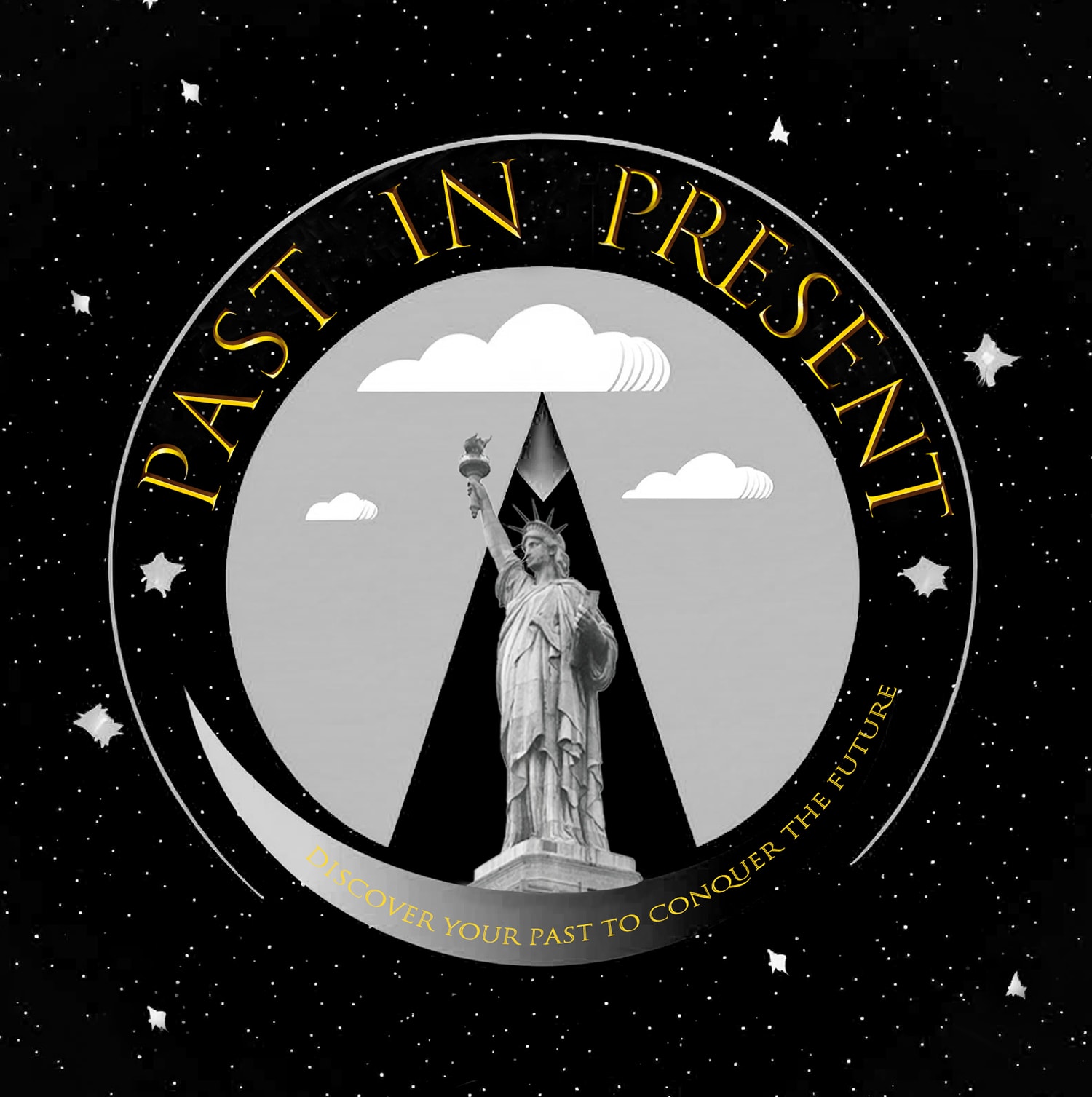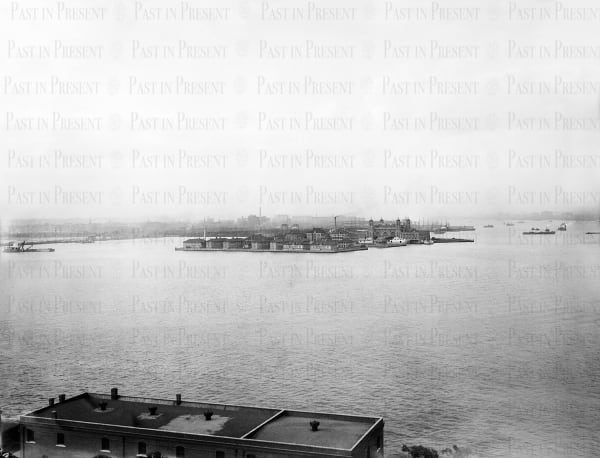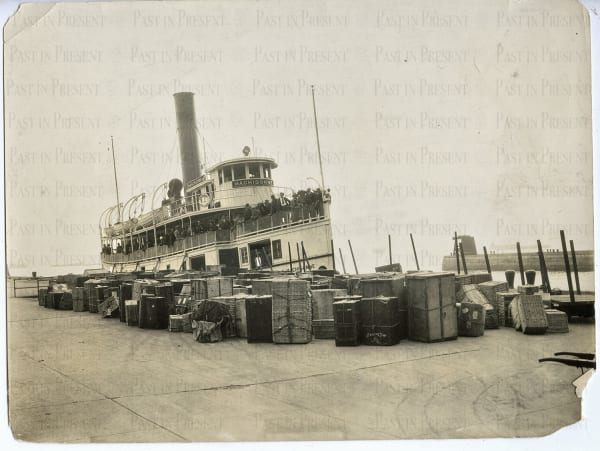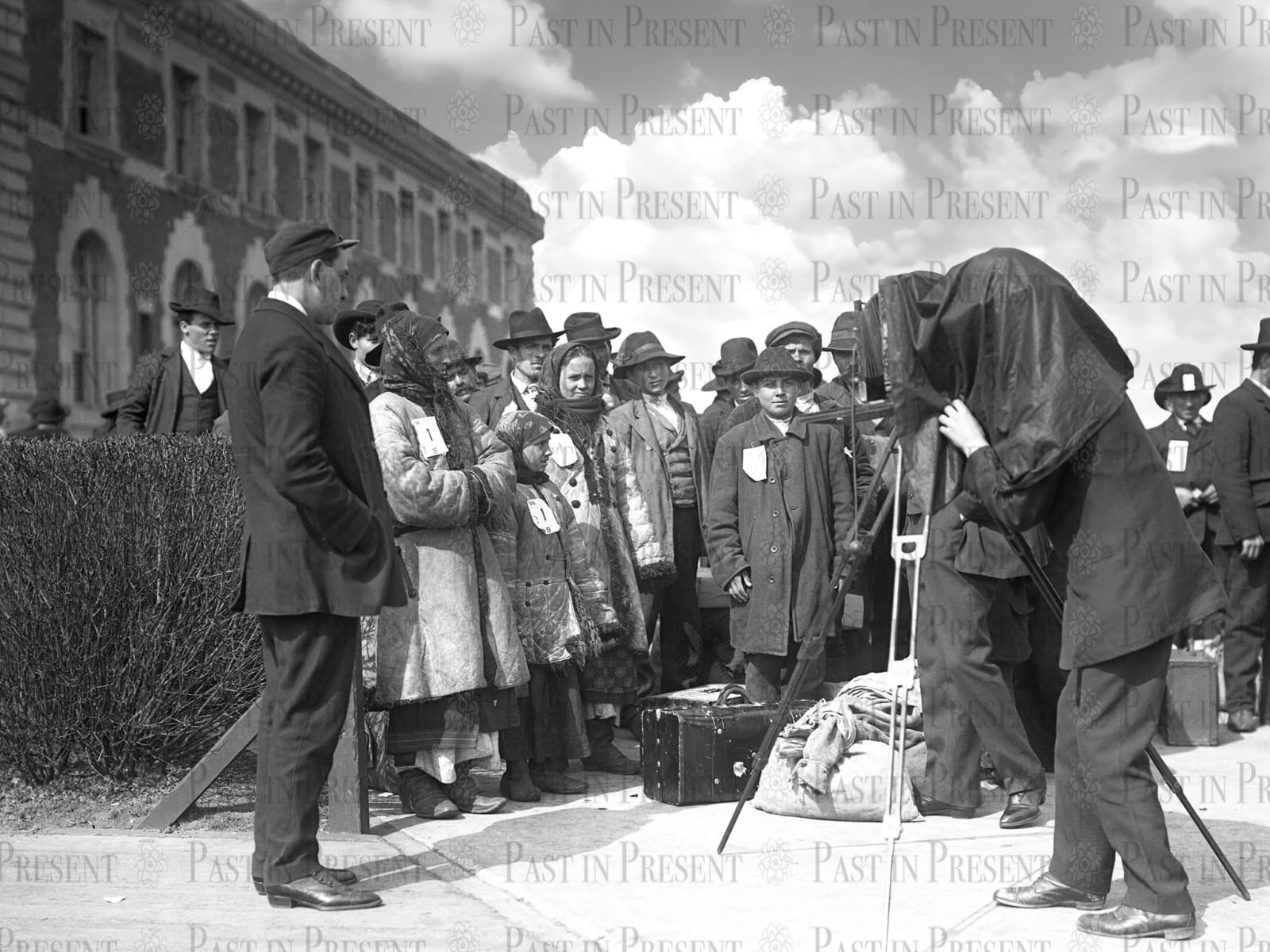At the turn of the 20th century, more than 12 million immigrants passed through Ellis Island, seeking not only a new life, but a new identity-one built on freedom, dignity, and possibility.
This exhibition, Through the Gates of Freedom, brings together 21 rare and emotionally charged images-many never seen by the public-capturing the powerful transformation of newly arrived immigrants as they stepped off ships and into the story of America.
From the first awe-struck glimpse of the Statue of Liberty to the final moments as they set foot on Manhattan soil, these original glass camera negatives and vintage silver gelatin photographs chart a deeply human journey: from fear to hope, from displacement to belonging, from being strangers to becoming citizens
These were ordinary people-Slovaks, Italians, Jews, Russians, Magyars, Poles-fleeing poverty, war, and oppression. They brought only what they could carry, including one treasure that could never be packed: dream of freedom, safety and prosperity.
They arrived with little, yet they became everything-scientists, artists, inventors, teachers, small business owners, and soldiers.
Among them:
Albert Einstein - The genius behind the theory of relativity, Einstein arrived in October 1933 at Ellis Island escaping Nazi persecution and later became a naturalized U.S. citizen . His advocacy and intellect helped spark scientific advancements that transformed modern physics-and ultimately shaped the 20th century.
Charlie Chaplin - The legendary British actor and filmmaker arrived in 1912, later becoming one of cinema's most influential figures
Madeleine Albright - Fleeing Communist Czechoslovakia, Albright arrived as a refugee and became the first woman U.S. Secretary of State
Irving Berlin, composer of God Bless America
Isaac Asimov, legendary sci-fi author
Joseph Pulitzer, news magnate
Golda Meir, Born in Ukraine, she immigrated to the U.S. before later becoming Prime Minister of Israel-a testament to the global influence of Ellis Island immigrants.
And millions of everyday Americans who shaped our cities, culture, economy, and values
At Ellis Island, between 1892 and 1924, over 12 million immigrants passed through a complex and often emotional process-but they were not left entirely to fend for themselves. Though the experience was often nerve-wracking, many were treated with a surprising degree of care, structure, and even compassion, especially by the standards of the time.
Here's a historical overview of how immigrants were treated and supported during their time at Ellis Island:
Shelter and Meals
Upon arrival, immigrants who required additional processing were provided with free temporary lodging in large dormitory-style rooms within the main building. These rooms were often crowded but offered basic protection from the elements.
They were given hot meals, including soup, bread, coffee, and meat, especially if they had to stay overnight or wait for transportation, further inspection, or assistance.
Medical Care and Screening
A comprehensive medical inspection was a mandatory part of entry. Doctors looked for visible signs of illness (especially contagious diseases like trachoma or tuberculosis) using a "six-second physical." Those who required further evaluation were marked with chalk and directed to special examination rooms.
Importantly, those found sick were not automatically deported-many received medical treatment in the island's hospital wards, one of the largest public health facilities in the U.S. at the time. Thousands recovered and were allowed to stay.
Education and Cultural Lessons
While Ellis Island was not a long-term housing facility, those who remained for extended stays-particularly children, young adults, or detained families-had access to basic educational lessons, including:
English language instruction
American civics lessons (including the U.S. Constitution and democratic values)
Guidance on how to navigate American customs, employment, and legal systems. These lessons were part of a broader effort to prepare immigrants for life in America and reduce cultural friction.
Intelligence and Legal Testing
Some immigrants were given intelligence or aptitude tests-not always fair by modern standards-to determine mental capacity or ability to work. These included puzzles, matching objects, or answering moral questions, particularly if an immigrant seemed mentally unfit or confused during questioning.
Legal questioning also took place to ensure immigrants weren't anarchists, criminals, or public charges. But for those needing help, interpreters, translators, and legal advocates (including charitable organizations) were often available.
Support from Charities and Reformers
Several social reformers and benevolent organizations operated on Ellis Island to assist immigrants. These included:
The Hebrew Immigrant Aid Society (HIAS)
Catholic and Protestant missions
Settlement house workers and volunteers, some of whom became lifelong advocates for immigrants
They helped with legal issues, appeals, finding lost family members, and even arranging jobs or housing in New York and beyond.
A Last Chance Before Deportation
Those deemed inadmissible had the right to appeal before a special Board of Inquiry or the "Court of Last Appeal." This was a final effort to convince the authorities of their eligibility to enter. Some succeeded, others were sent back-but the process was often more humane than expected, with dignity preserved whenever possible.
A Balance of Hope and Hardship
While not free of bureaucracy or prejudice, Ellis Island represented a unique intersection of order and opportunity. Immigrants were not simply dumped into a system-they were given medical attention, food, beds, legal process, and in many cases, education.
For millions, it was the first glimpse of a government offering them a future, and that made all the difference.
From the Gates of Freedom to the Walls of Detention: A Reflection on Then and Now
At the turn of the 20th century, millions passed through Ellis Island-tired, poor, hopeful souls seeking refuge and a better life. Despite the hardships of long voyages, uncertainty, and bureaucratic hurdles, they were met with a process grounded-at least in principle-in humanity. Immigrants were given hot meals, shelter, medical care, English lessons, and
education about the Constitution. They were treated not as criminals, but as future Americans. They were viewed as the builders of the nation they would soon help shape.
Fast forward to today, and we must ask ourselves: What has happened to that American promise?
Across the United States, places like the South Texas Family Residential Center, the Adelanto ICE Processing Center, and the infamous "Alligator Alcatraz" in Florida have become symbols of cruelty rather than compassion. These modern-day detention centers-some privately run for profit-resemble carceral institutions more than points of welcome. Families are torn apart. Children sleep on cold floors under aluminum blankets. Hope is replaced with fear. Legal protections often vanish into bureaucratic limbo.
And the world is watching-with disbelief, sorrow, and moral judgment.
We were once called "the envy of the world"-a nation that embraced the tired, the poor, the huddled masses yearning to breathe free. But can we still claim that mantle if we abandon the very ideals that built our greatness?
If we want to remain a beacon of liberty and justice, we must return to treating immigrants with dignity, not detention. We must honor those who came before-and those still coming-not with walls and cages, but with pathways to contribution, community, and citizenship.
Immigrants built this nation. Respecting them is not charity-it is national self-respect.
If we truly hope to be "the envy of the world" again, we must prove we deserve to be.
-

“Through the Lens of Liberty: Faces of the New World” Ellis Island immigrants NYC, c.1900s
“Through the Lens of Liberty: Faces of the New World” Ellis Island immigrants NYC, c.1900s, c.1900sHigh quality digital print produced from digital file created from original vintage glass camera negative and printed on 100% cotton Canson Infinity Platine Fibre Rag photo paper 310g/m2. Watermarks do not appear on the actual artwork. (Watermarks do not appear on the actual artwork.)
Print carefully fitted in 18 X 24" Bright White 100% cotton pre-cut Museum Exhibition mat board fully assembled with a 4-ply beveled window and a 2-ply backing board, hinged together with linen tape
13 x 19 in
33 x 48.3 cm
Edition of 50 -
-

The Last Gate: Queue to the Registry, Ellis Island
The Last Gate: Queue to the Registry, Ellis Island, c.1900sFine Art Print produced from digital file created from original vintage glass camera negative and printed on 100% cotton Canson Infinity Platine Fibre Rag Archival photo paper 310g/m2. Watermarks do not appear on the actual artwork.
Print carefully fitted in 18" X 24" Bright White 100% cotton pre-cut Museum Exhibition mat board fully assembled with a double 4-ply beveled window and a 4-ply backing board,
13 x 19 in
33 x 48.3 cm
Edition of 50 -

“Bread and Hope: A Family’s First Meal in America” Ellis Island NYC, c.1900s”
“Bread and Hope: A Family’s First Meal in America” Ellis Island NYC, c.1900s”, c.1900sFine Art Print produced from digital file created from original vintage glass camera negative and printed on 100% cotton Canson Infinity Platine Fibre Rag photo paper 310g/m2. (Watermarks do not appear on the actual artwork.)
Print carefully fitted in 18 X 24" Bright White 100% cotton pre-cut Museum Exhibition mat board fully assembled with a 4-ply beveled window and a 2-ply backing board, hinged together with linen tape
13 x 19 in
33 x 48.3 cm
Edition of 50 -

Children of Exile, Russian Immigrant Children Face the Unknown at Ellis Island, c.1900s
Children of Exile, Russian Immigrant Children Face the Unknown at Ellis Island, c.1900s, c.1900sFine Art Print produced from digital file created from original vintage glass camera negative and printed on 100% cotton Canson Infinity Platine Fibre Rag Archival photo paper 310g/m2. Watermarks do not appear on the actual artwork.
Print carefully fitted in 18" X 24" Bright White 100% cotton pre-cut Museum Exhibition mat board fully assembled with a double 4-ply beveled window and a 4-ply backing board,
13 x 19 in
33 x 48.3 cm
Edition of 50 -

-

-

-

Docking Dreams: The Final Step to Freedom in Manhattan, c.1900s
Docking Dreams: The Final Step to Freedom in Manhattan, c.1900s, c.1900sFine Art Print produced from digital file created from original vintage glass camera negative and printed on 100% cotton Canson Infinity Platine Fibre Rag Archival photo paper 310g/m2. Watermarks do not appear on the actual artwork.
Print carefully fitted in 18" X 24" Bright White 100% cotton pre-cut Museum Exhibition mat board fully assembled with a double 4-ply beveled window and a 4-ply backing board,
13 x 19 in
33 x 48.3 cm
Edition of 50 -

First Steps in Manhattan. The journey ends — and a new life begins on American soil. Ellis Island, 1907
First Steps in Manhattan. The journey ends — and a new life begins on American soil. Ellis Island, 1907, 1907Let’s Keep Exploring History Together
Thank you for joining us in Through the Gates of Freedom. If you’d like to be the first to know about future exhibitions, new discoveries, and stories from America’s past—subscribe via our Contact Page and check the newsletter box.
Have a topic you’d love to see covered—perhaps something about early 20th-century NYC life, immigration, or untold American stories? Send us a note. Your input helps guide our next historical deep dives.
Together, we keep the past alive!























